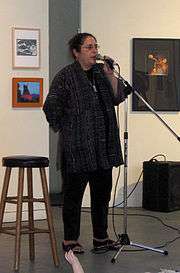Brulé
|
Janeen Antoine (Sicangu Lakota), curator and educator[1] | |
| Regions with significant populations | |
|---|---|
|
( | |
| Languages | |
| Lakota, English | |
| Religion | |
|
traditional tribal religion, Sun Dance, Native American Church, Christianity | |
| Related ethnic groups | |
| other Lakota people) |
The Brulé are one of the seven branches or bands (sometimes called "sub-tribes") of the Teton (Titonwan) Lakota American Indian people. They are known as Sičháŋǧu Oyáte (in Lakota), or "Burnt Thighs Nation", and so, were called Brulé (literally "burnt") by the French. The name may have derived from an incident where they were fleeing through a grass fire on the plains.
Distribution
Many Sicangu people live on the Rosebud Indian Reservation in southwestern South Dakota and are enrolled in the federally recognized Rosebud Sioux Tribe, known as Sicangu Oyate. A smaller population lives on the Lower Brule Indian Reservation, on the west bank of the Missouri River in central South Dakota. Others live on Pine Ridge Indian Reservation. The different federally recognized tribes are politically independent of each other.
Name

The term "Sičhą́ǧu" appears on pages 3 to 14 of Beginning Lakhota.[2]
"Ká Lakȟóta kį líla hą́ske. 'That Indian (over yonder) is very tall.'"
"Hą, hé Sičhą́ǧú. 'Yes, that's a Rosebud Sioux.'"
It appears to be a compound word of the Thítȟųwą Lakȟóta dialect meaning "burned thigh".[3]
Historic Brulé Tiyošpaye or bands
Together with the Oglala Lakota, who are mostly based at the Pine Ridge Indian Reservation, they are often called Southern Lakota. They were divided in three great regional tribal divisions:
- Lower Brulé (Kul Wicasa Oyate, ″Lowland People″, lived along the White River to its mouth into the Missouri River (Mnišoše) as well in the Missouri River Valley in South Dakota, some ventured south to the Niobrara River)[4]
- Upper Brulé (Heyata Wicasa Oyate - ″Highland People″, ventured further south and west onto the Plains along the Platte River between the North and South Platte River in Nebraska in the search for buffalo, the allied Southern Cheyenne and Southern Arapaho welcomed them as strong allies to this lands which they had further claimed, along the Loup River - the former center of the Skidi or Wolf/Loup Pawnee - they went down south to plunder enemy Pawnee and Arikara camps, therefore also known as: Kheyatawhichasha - ″People away from the (Missouri) River″)
- (Upper) Brulé of the Platte River (actually a splinter group of the Upper Brulé and the southernmost Brulé group, generally along the South Platte River in Colorado with hunting bands south to the Republican River - home to the enemy Kithehaki / Kitkehaxki of the South Bands Pawnee, also known as: Kheyatawhichasha - ″People away from the (Missouri) River″)
According to the Brulé Medicine Bull (Tatánka Wakan), the people were decentralized and identified with the following tiyošpaye or extended family groups who collected in various local tiwahe (English: Camps or family circles):
- Iyakoza
- Chokatowela
- Shiyolanka
- Kanghi yuha
- Pispiza wichasha
- Waleghaunwohan
- Wacheunpa
- Shawala
- Ihanktonwan
- Nakhpakhpa
- Apewantanka
Notable Sicangu (Brulé)

- Mary Brave Bird, author
- Leonard Crow Dog, spiritual leader, American Indian Movement activist
- Paul Eagle Star (1866-24 August 1891), performer with Buffalo Bill's Wild West Show
- Hollow Horn Bear, chief
- Iron Nation, chief
- Iron Shell, chief
- Little Thunder, chief
- Arnold Short Bull, a well-known Sicangu holy man, who brought the Ghost Dance to the Lakota in South Dakota in 1890
- Michael Spears, actor
- Eddie Spears, actor
- Spotted Tail or "Sinte Gleska", 19th-century chief[5]
- Moses Stranger Horse, artist
- Two Strike, chief
- Albert White Hat, Lakota language teacher
- Dyani White Hawk, contemporary painter and former curator of All My Relations Arts gallery
- Chauncey Yellow Robe, educator, lecturer and activist
- Rosebud Yellow Robe, folklorist, educator and author
- Rosalie Little Thunder spiritual activist, language teacher, bead worker
- Frank Waln, is a Sicangu Lakota rapper
See also
References
- ↑ "Native American Heritage Month: S.F. gallery director wins praise for breaking with past." San Francisco Chronicle. 12 Nov 1995 (retrieved 20 Dec 2009)
- ↑ Beginning Lakhota, Volume 1, (Boulder: University of Colorado Lakhota Project, 1976).
- ↑ Famous Indians of Northwest Nebraska. Chadron Centennial Committee. 1983. p. 34.
- ↑ Lower Brule
- ↑ Brown, Dee (1970). Bury My Heart at Wounded Knee, ch. 6. Bantam Books. ISBN 0-553-11979-6.
External links
| Wikimedia Commons has media related to Brulé Sioux. |
- Official website of the Sicangu Oyate, Rosebud Sioux Tribe
- Indian genealogy
- Official website of the Kul Wicasa Oyate (Lower Brule)
